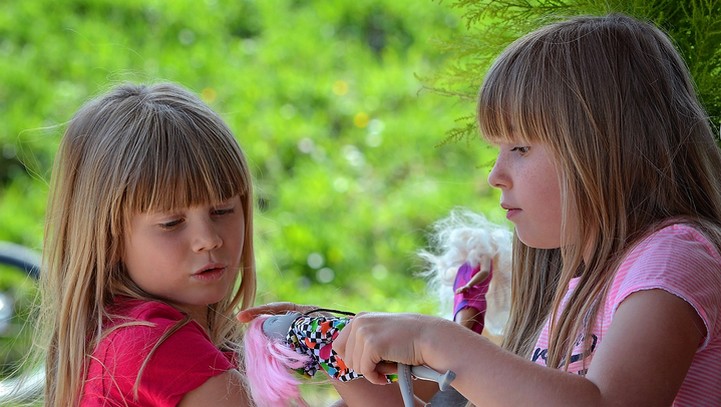
Many preschoolers have problems sharing, taking turns, and negotiating roles when they play together. These day-to-day conflicts are great opportunities for child care providers to help 3- to 5-year-olds practice the skills needed to resolve disagreements. Even the youngest preschoolers can learn the basics of conflict resolution with appropriate help and guidance from supportive child care providers.
Benefits of Teaching Conflict Resolution to Young Children
Learning to handle conflicts in productive ways is an important social skill that children will use throughout their lives. When child care providers help preschoolers practice resolving conflicts, they become more sensitive to the needs and feelings of others. Children also develop self-confidence when they learn how to solve their problems in a positive and assertive way. Conflict resolution involves good communication, real listening, and searching for solutions that children can agree to. This kind of problem solving teaches children how to think creatively and to evaluate solutions.
Steps in Resolving Conflicts
Child care providers can begin teaching children to negotiate and solve disagreements by guiding them through some simple steps. Remember that children need repeated practice to resolve conflicts. Child care providers will need to lead children through the steps at first. With repeated practice, preschoolers and school-age children can learn to work through these steps by themselves.
- Find a quiet place to talk. Before helping children resolve the conflict, child care providers need to remove children from the place where the conflict occurred. Find a quiet place in the room where everyone can sit and discuss the situation without interruptions.
-
Set ground rules. Conflicts raise strong emotions in most children. Ground rules will help ensure that children discuss the situation rationally and arrive at a solution that all children are willing to try. Common ground rules for children resolving conflicts include:
- Everyone gets a say.
- Everyone listens without interrupting.
- Everyone gets to propose a solution.
- All solutions must be discussed.
- The group must choose the best solution together.
- Give each person a say. Go around the circle and ask each child to tell her side of the story. Use questions like “Amy, what happened?” and “Beth, what happened?” to allow each child to share. Remind children to listen without interrupting. Be sure everyone has the chance to speak about the problem.
- State the problem clearly. Based on the information that all children shared, summarize the problem in a few words. You might say something like, “Amy and Beth, it sounds like you both want to be the mother in dramatic play. Is that right?”
- Ask each person to suggest a solution. Go around the circle again and ask each person, “What do you think we should do to solve this problem?” Again, remind children to listen without interrupting. Encourage each child to suggest a solution, even if the suggestion is the same as the one proposed by another child.
- Help the group choose a solution. Guide the children in discussing the pros and cons of each solution. Ask them to think about how they would feel about that solution, and encourage them to consider how the solution would affect others as well as themselves. For example, you might say, “Amy has suggested that both of you get to be the mother and take care of your own babies. Beth, how would you feel about that solution? Are there any problems with this idea?”
- Put the solution into effect. Congratulate the children on coming up with a solution together. Go with the children as they begin trying out their solution. Remind them of the agreement if children are not following the solution chosen.
- Observe and check in if needed. Watch the children interact for a little while. Watch the ways that they are playing together, and pay attention to any problems that still seem to be happening. If the solution is not working, or children are unhappy with the solution, bring the group back together to renegotiate a better solution.
With time and repeated practice, preschoolers can learn to use these steps to solve problems without the help of their child care provider. Resolving conflicts helps children learn valuable communication skills and can encourage them to be more accepting of different points of view.
For More Information
Remember that guiding children’s behavior is an ongoing process. For more information, check out the eXtension Alliance for Better Child Care section on Guidance and Discipline in Child Care. Specific articles that may be of interest include the following:
